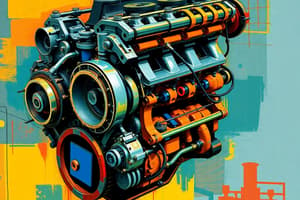Podcast
Questions and Answers
What is the function of the crankshaft?
What is the function of the crankshaft?
- To convert up-and-down motion of pistons into rotary motion (correct)
- To operate valves that allow air and fuel into cylinders
- To convert rotary motion into up-and-down motion
- To ignite air and fuel in the cylinders
Which engine type uses a spark plug to ignite air and fuel?
Which engine type uses a spark plug to ignite air and fuel?
- Spark Ignition (SI) Engine (correct)
- Fuel Injection Engine
- Carburetor Engine
- Compression Ignition (CI) Engine
What is the purpose of the camshaft?
What is the purpose of the camshaft?
- To convert up-and-down motion of pistons into rotary motion
- To convert rotary motion into up-and-down motion
- To operate valves that allow air and fuel into cylinders (correct)
- To spray fuel into cylinders
What is measured in miles per gallon (mpg) or liters per 100 kilometers (L/100km)?
What is measured in miles per gallon (mpg) or liters per 100 kilometers (L/100km)?
What is the unit of measurement for engine power?
What is the unit of measurement for engine power?
What is the total volume of all cylinders measured in?
What is the total volume of all cylinders measured in?
Study Notes
Basic Components
- Cylinders: Where combustion takes place
- Pistons: Move up and down in cylinders, driven by explosive force of combustion
- Crankshaft: Converts up-and-down motion of pistons into rotary motion
- Camshaft: Operates valves that allow air and fuel into cylinders and exhaust gases out
- Valves: Control flow of air and fuel into cylinders and exhaust gases out
Four-Stroke Cycle
- Intake: Air and fuel enter cylinder through intake valve
- Compression: Intake valve closes, piston moves up, compressing air and fuel
- Power: Spark plug ignites air and fuel, causing piston to move down
- Exhaust: Exhaust valve opens, piston moves up, pushing exhaust gases out
Engine Types
- Spark Ignition (SI) Engine: Uses spark plug to ignite air and fuel (e.g., gasoline engine)
- Compression Ignition (CI) Engine: Uses heat generated by compression to ignite air and fuel (e.g., diesel engine)
Fuel Systems
- Carburetor: Mixes air and fuel for older engines
- Fuel Injection: Sprays fuel into cylinders at precise times for modern engines
Emissions and Efficiency
- Emissions: Harmful gases released by engine, including CO, HC, NOx, and PM
- Fuel Efficiency: Measured by miles per gallon (mpg) or liters per 100 kilometers (L/100km)
- Emissions Control: Systems to reduce emissions, such as catalytic converters and exhaust gas recirculation
Additional Concepts
- Torque: Rotational force of engine, measured in Newton-meters (Nm) or foot-pounds (ft-lb)
- Horsepower: Unit of measurement for engine power, calculated from torque and engine speed
- Engine Displacement: Total volume of all cylinders, measured in liters (L) or cubic inches (in³)
Studying That Suits You
Use AI to generate personalized quizzes and flashcards to suit your learning preferences.
Description
Test your knowledge of the fundamental components and processes of internal combustion engines, including cylinders, pistons, crankshafts, and more. Learn about the four-stroke cycle, engine types, fuel systems, emissions, and efficiency. Evaluate your understanding of torque, horsepower, and engine displacement.




